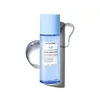What's inside
What's inside
 Key Ingredients
Key Ingredients

 Benefits
Benefits

 Concerns
Concerns

No concerns
 Ingredients Side-by-side
Ingredients Side-by-side

Water
Skin ConditioningDipropylene Glycol
HumectantPEG/PPG-17/6 Copolymer
SolventPEG/PPG/Polybutylene Glycol-8/5/3 Glycerin
HumectantSodium Hyaluronate
HumectantSodium Acetylated Hyaluronate
HumectantHydrolyzed Sodium Hyaluronate
Skin ConditioningSodium Hyaluronate Crosspolymer
HumectantCentella Asiatica Extract
CleansingCeramide EOP
Skin ConditioningCeramide Ns
Skin ConditioningCeramide AP
Skin ConditioningHydrogenated Lecithin
EmulsifyingCeramide As
Skin ConditioningCeramide NP
Skin ConditioningPanthenol
Skin ConditioningAllantoin
Skin ConditioningChlorphenesin
AntimicrobialPullulan
Ethylhexylglycerin
Skin ConditioningHydroxyethylcellulose
Emulsion StabilisingGlycerin
HumectantTrehalose
HumectantSophora Flavescens Root Extract
AntioxidantOpuntia Ficus-Indica Stem Extract
Skin ConditioningOphiopogon Japonicus Root Extract
Skin ConditioningPentylene Glycol
Skin Conditioning1,2-Hexanediol
Skin ConditioningDisodium EDTA
Butylene Glycol
HumectantSodium Acetate
BufferingCellulose
AbsorbentGentiana Scabra Extract
HumectantWater, Dipropylene Glycol, PEG/PPG-17/6 Copolymer, PEG/PPG/Polybutylene Glycol-8/5/3 Glycerin, Sodium Hyaluronate, Sodium Acetylated Hyaluronate, Hydrolyzed Sodium Hyaluronate, Sodium Hyaluronate Crosspolymer, Centella Asiatica Extract, Ceramide EOP, Ceramide Ns, Ceramide AP, Hydrogenated Lecithin, Ceramide As, Ceramide NP, Panthenol, Allantoin, Chlorphenesin, Pullulan, Ethylhexylglycerin, Hydroxyethylcellulose, Glycerin, Trehalose, Sophora Flavescens Root Extract, Opuntia Ficus-Indica Stem Extract, Ophiopogon Japonicus Root Extract, Pentylene Glycol, 1,2-Hexanediol, Disodium EDTA, Butylene Glycol, Sodium Acetate, Cellulose, Gentiana Scabra Extract
Water
Skin ConditioningPropanediol
SolventGlycerin
HumectantButylene Glycol
HumectantCarbomer
Emulsion StabilisingSilica
AbrasiveDisodium Succinate
MaskingPotassium Hydroxide
BufferingMethylparaben
PreservativePhenoxyethanol
PreservativeSuccinic Acid
BufferingDisodium EDTA
Polysorbate 20
EmulsifyingStyrene/Vp Copolymer
Xanthan Gum
EmulsifyingBetaine
HumectantSodium Chloride
MaskingAscorbyl Glucoside
AntioxidantArginine
MaskingMenthol
MaskingMagnesium Aspartate
Skin ConditioningZinc Gluconate
Skin ConditioningMentha Arvensis Leaf Oil
MaskingPropylene Glycol
HumectantZinc Hydrolyzed Hyaluronate
HumectantCalcium Chloride
AstringentPotassium Chloride
Copper Gluconate
Skin ConditioningRosmarinus Officinalis Leaf Oil
MaskingEucalyptus Globulus Leaf Oil
PerfumingAcrylic Acid
Sorbic Acid
PreservativeCoix Lacryma-Jobi Ma-Yuen Seed Extract
Skin ConditioningWater, Propanediol, Glycerin, Butylene Glycol, Carbomer, Silica, Disodium Succinate, Potassium Hydroxide, Methylparaben, Phenoxyethanol, Succinic Acid, Disodium EDTA, Polysorbate 20, Styrene/Vp Copolymer, Xanthan Gum, Betaine, Sodium Chloride, Ascorbyl Glucoside, Arginine, Menthol, Magnesium Aspartate, Zinc Gluconate, Mentha Arvensis Leaf Oil, Propylene Glycol, Zinc Hydrolyzed Hyaluronate, Calcium Chloride, Potassium Chloride, Copper Gluconate, Rosmarinus Officinalis Leaf Oil, Eucalyptus Globulus Leaf Oil, Acrylic Acid, Sorbic Acid, Coix Lacryma-Jobi Ma-Yuen Seed Extract
 Reviews
Reviews

Ingredients Explained
These ingredients are found in both products.
Ingredients higher up in an ingredient list are typically present in a larger amount.
Butylene Glycol (or BG) is used within cosmetic products for a few different reasons:
Overall, Butylene Glycol is a safe and well-rounded ingredient that works well with other ingredients.
Though this ingredient works well with most skin types, some people with sensitive skin may experience a reaction such as allergic rashes, closed comedones, or itchiness.
Learn more about Butylene GlycolDisodium EDTA plays a role in making products more stable by aiding other preservatives.
It is a chelating agent, meaning it neutralizes metal ions that may be found in a product.
Disodium EDTA is a salt of edetic acid and is found to be safe in cosmetic ingredients.
Learn more about Disodium EDTAGlycerin is already naturally found in your skin. It helps moisturize and protect your skin.
A study from 2016 found glycerin to be more effective as a humectant than AHAs and hyaluronic acid.
As a humectant, it helps the skin stay hydrated by pulling moisture to your skin. The low molecular weight of glycerin allows it to pull moisture into the deeper layers of your skin.
Hydrated skin improves your skin barrier; Your skin barrier helps protect against irritants and bacteria.
Glycerin has also been found to have antimicrobial and antiviral properties. Due to these properties, glycerin is often used in wound and burn treatments.
In cosmetics, glycerin is usually derived from plants such as soybean or palm. However, it can also be sourced from animals, such as tallow or animal fat.
This ingredient is organic, colorless, odorless, and non-toxic.
Glycerin is the name for this ingredient in American English. British English uses Glycerol/Glycerine.
Learn more about GlycerinWater. It's the most common cosmetic ingredient of all. You'll usually see it at the top of ingredient lists, meaning that it makes up the largest part of the product.
So why is it so popular? Water most often acts as a solvent - this means that it helps dissolve other ingredients into the formulation.
You'll also recognize water as that liquid we all need to stay alive. If you see this, drink a glass of water. Stay hydrated!
Learn more about Water